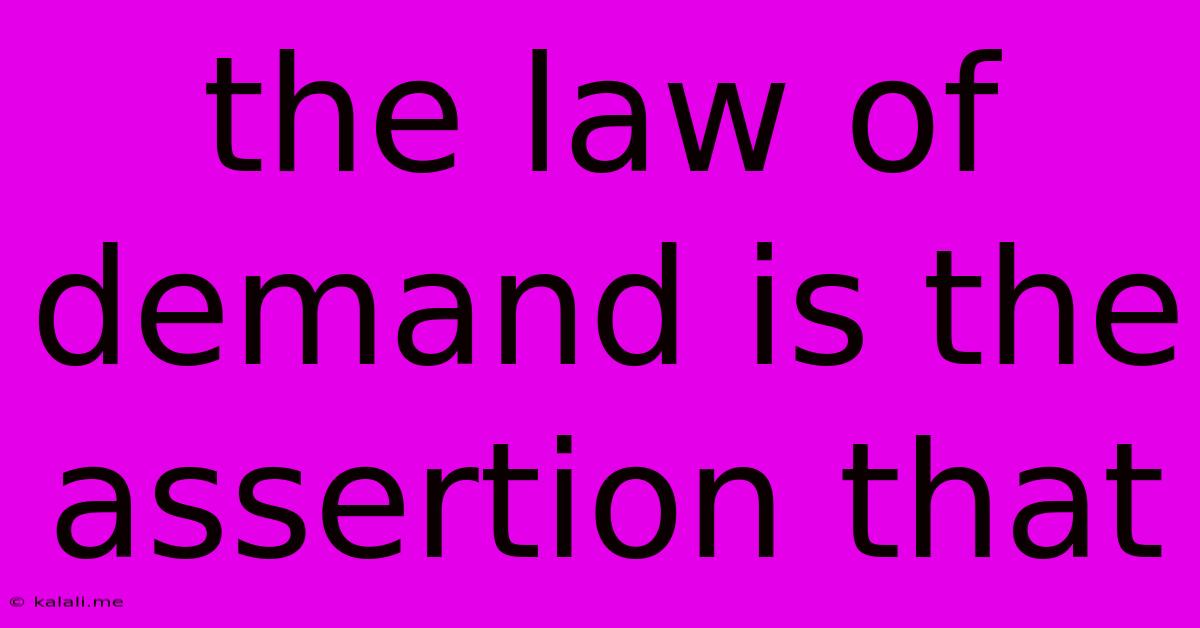The Law Of Demand Is The Assertion That
Kalali
Jun 15, 2025 · 3 min read

Table of Contents
The Law of Demand: A Deep Dive into Consumer Behavior
The law of demand is a fundamental principle in economics that asserts that, all other factors being equal, the quantity demanded of a good or service is inversely proportional to its price. In simpler terms, as the price of something goes up, people will generally buy less of it; conversely, as the price goes down, people will buy more. This inverse relationship forms the foundation of understanding market dynamics and consumer behavior. This article will explore the law of demand in detail, examining its core tenets, influencing factors, and exceptions.
Understanding the Inverse Relationship
The law of demand is based on the principle of diminishing marginal utility. This means that as a consumer consumes more units of a good or service, the additional satisfaction (utility) they receive from each extra unit decreases. If the price of a product remains constant, consumers will purchase more units until the marginal utility drops to a level where the satisfaction no longer justifies the cost. Consequently, if the price increases, the marginal utility must be higher to justify the purchase, resulting in a lower quantity demanded.
For example, imagine someone buying slices of pizza. The first slice might be incredibly satisfying, the second still enjoyable, but by the fifth or sixth, the enjoyment diminishes significantly. If the price per slice remains unchanged, they may continue eating, but if the price drastically increases, the diminishing marginal utility might make them stop at fewer slices.
Factors Affecting Demand Beyond Price
While price is the primary driver of the law of demand, several other factors can influence the quantity demanded, even if the price stays the same. These are often referred to as "ceteris paribus" conditions, meaning "all other things being equal." When these factors change, the entire demand curve shifts. These factors include:
- Consumer Income: An increase in income generally leads to an increase in demand for normal goods (goods for which demand increases as income rises), while demand for inferior goods (goods for which demand decreases as income rises) may decrease.
- Prices of Related Goods: The demand for a good can be affected by the prices of substitutes (goods that can be used in place of the original good) and complements (goods that are consumed together). A price increase in a substitute good will increase demand for the original good, while a price increase in a complement good will decrease demand for the original good.
- Consumer Tastes and Preferences: Changes in fashion, trends, or consumer tastes can significantly impact demand. A popular new product can experience a surge in demand, while an outdated product might see its demand decline.
- Consumer Expectations: Expectations about future prices or availability can also influence current demand. If consumers anticipate a price increase, they may buy more now, increasing current demand.
- Number of Buyers: A larger number of buyers in the market will naturally increase the overall demand for a good or service.
Exceptions to the Law of Demand
While the law of demand holds true in most situations, there are some exceptions:
- Giffen Goods: These are inferior goods for which demand increases as price increases. This typically occurs when the good represents a significant portion of a consumer's budget, and the price increase outweighs the reduction in purchasing power.
- Veblen Goods: These are luxury goods where demand increases as price increases, driven by the prestige and status associated with high prices. The higher the price, the more desirable the product becomes.
- Speculative Markets: In markets driven by speculation, such as the stock market or real estate, demand can increase even as prices rise, based on expectations of future price appreciation.
Conclusion
The law of demand is a cornerstone of economic theory, providing a framework for understanding how consumers respond to price changes. While exceptions exist, the inverse relationship between price and quantity demanded generally holds true. Understanding this fundamental principle is crucial for businesses making pricing decisions, for policymakers implementing economic policies, and for anyone interested in analyzing market behavior. By considering the factors that influence demand beyond price, a more complete picture of consumer behavior can be formed.
Latest Posts
Latest Posts
-
Which Of The Following Is The Largest
Jun 15, 2025
-
A Real Gas Behaves Most Like An Ideal Gas At
Jun 15, 2025
-
Which Of The Following Is Not A Fundamental Unit
Jun 15, 2025
-
Find The Mean Proportional Between 6 And 24
Jun 15, 2025
-
The Opportunity Cost Of Money Holdings Is
Jun 15, 2025
Related Post
Thank you for visiting our website which covers about The Law Of Demand Is The Assertion That . We hope the information provided has been useful to you. Feel free to contact us if you have any questions or need further assistance. See you next time and don't miss to bookmark.